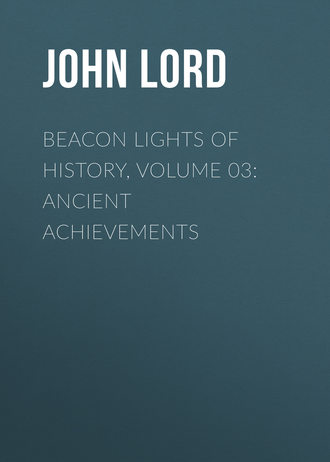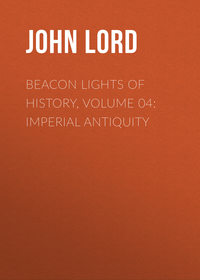 полная версия
полная версияBeacon Lights of History, Volume 03: Ancient Achievements
Other famous geometers could also be named, but such men as Euclid, Archimedes, and Apollonius are enough to show that geometry was cultivated to a great extent by the philosophers of antiquity. It progressively advanced, like philosophy itself, from the time of Thales until it had reached the perfection of which it was capable, when it became merged into astronomical science. It was cultivated more particularly by the disciples of Plato, who placed over his school this inscription: "Let no one ignorant of geometry enter here." He believed that the laws by which the universe is governed are in accordance with the doctrines of mathematics. The same opinion was shared by Pythagoras, the great founder of the science, whose main formula was that number is the essence or first principle of all things. No thinkers ever surpassed the Greeks in originality and profundity; and mathematics, being highly prized by them, were carried to the greatest perfection their method would allow. They did not understand algebra, by the application of which to geometry modern mathematicians have climbed to greater heights than the ancients; but then it is all the more remarkable that without the aid of algebraic analysis they were able to solve such difficult problems as occupied the minds of Archimedes and Apollonius. No positive science can boast of such rapid development as geometry for two or three hundred years before Christ, and never was the intellect of man more severely tasked than by the ancient mathematicians.
No empirical science can be carried to perfection by any one nation or in any particular epoch; it can only expand with the progressive developments of the human race itself. Nevertheless, in that science which for three thousand years has been held in the greatest honor, and which is one of the three great liberal professions of our modern times, the ancients, especially the Greeks, made considerable advance. The science of medicine, having in view the amelioration of human misery and the prolongation of life itself, was very early cultivated. It was, indeed, in old times another word for physics,–the science of Nature,–and the physician was the observer and expounder of physics. The physician was supposed to be acquainted with the secrets of Nature,–that is, the knowledge of drugs, of poisons, of antidotes to them, and the way to administer them. He was also supposed to know the process of preserving the body after death. Thus Joseph, seventeen hundred years before the birth of Christ, commanded his physician to embalm the body of his father; and the process of embalming was probably known to the Egyptians before the period when history begins. Helen, of Trojan fame, put into wine a drug that "frees man from grief and anger, and causes oblivion of all ills." Solomon was a great botanist,–a realm with which the science of medicine is indissolubly connected. The origin of Hindu medicine is lost in remote antiquity. The Ayur Veda, written nine hundred years before Hippocrates was born, sums up the knowledge of previous periods relating to obstetric surgery, to general pathology, to the treatment of insanity, to infantile diseases, to toxicology, to personal hygiene, and to diseases of the generative functions.
Thus Hippocrates, the father of European medicine, must have derived his knowledge not merely from his own observations, but from the writings of men unknown to us and from systems practised for an indefinite period. The real founders of Greek medicine are fabled characters, like Hercules and Aesculapius,–that is, benefactors whose fictitious names alone have descended to us. They are mythical personages, like Hermes and Chiron. Twelve hundred years before Christ temples were erected to Aesculapius in Greece, the priests of which were really physicians, and the temples themselves hospitals. In them were practised rites apparently mysterious, but which modern science calls by the names of mesmerism, hydropathy, the use of mineral springs, and other essential elements of empirical science. And these temples were also medical schools. That of Cos gave birth to Hippocrates, and it was there that his writings were begun. Pythagoras–for those old Grecian philosophers were the fathers of all wisdom and knowledge, in mathematics and empirical sciences as well as philosophy itself–studied medicine in the schools of Egypt, Phoenicia, Chaldaea, and India, and came in conflict with sacerdotal power, which has ever been antagonistic to new ideas in science. He travelled from town to town as a teacher or lecturer, establishing communities in which medicine as well as numbers was taught.
The greatest name in medical science in ancient or in modern times, the man who did the most to advance it, the greatest medical genius of whom we have any early record, was Hippocrates, born on the island of Cos, 460 B.C., of the great Aesculapian family. He received his instruction from his father. We know scarcely more of his life than we do of Homer himself, although he lived in the period of the highest splendor of Athens. Even his writings, like those of Homer, are thought by some to be the work of different men. They were translated into Arabic, and were no slight means of giving an impulse to the Saracenic schools of the Middle Ages in that science in which the Saracens especially excelled. The Hippocratic collection consists of more than sixty works, which were held in the highest estimation by the ancient physicians. Hippocrates introduced a new era in medicine, which before his time had been monopolized by the priests. He carried out a system of severe induction from the observation of facts, and is as truly the creator of the inductive method as Bacon himself. He abhorred theories which could not be established by facts; he was always open to conviction, and candidly confessed his mistakes; he was conscientious in the practice of his profession, and valued the success of his art more than silver and gold. The Athenians revered Hippocrates for his benevolence as well as genius. The great principle of his practice was trust in Nature; hence he was accused of allowing his patients to die. But this principle has many advocates among scientific men in our day; and some suppose that the whole successful practice of Homoeopathy rests on the primal principle which Hippocrates advanced, although the philosophy of it claims a distinctly scientific basis in the principle similia similibus curantur. Hippocrates had great skill in diagnosis, by which medical genius is most severely tested; his practice was cautious and timid in contrast with that of his contemporaries. He is the author of the celebrated maxim, "Life is short and art is long." He divides the causes of disease into two principal classes,–the one comprehending the influence of seasons, climates, and other external forces; the other including the effects of food and exercise. To the influence of climate he attributes the conformation of the body and the disposition of the mind; to a vicious system of diet he attributes innumerable forms of disease. For more than twenty centuries his pathology was the foundation of all the medical sects. He was well acquainted with the medicinal properties of drugs, and was the first to assign three periods to the course of a malady. He knew but little of surgery, although he was in the habit of bleeding, and often employed the knife; he was also acquainted with cupping, and used violent purgatives. He was not aware of the importance of the pulse, and confounded the veins with the arteries. Hippocrates wrote in the Ionic dialect, and some of his works have gone through three hundred editions, so highly have they been valued. His authority passed away, like that of Aristotle, on the revival of science in Europe. Yet who have been greater ornaments and lights than these two distinguished Greeks?
The school of Alexandria produced eminent physicians, as well as mathematicians, after the glory of Greece had departed. So highly was it esteemed that Galen in the second century,–born in Greece, but famous in the service of Rome,–went there to study, five hundred years after its foundation. It was distinguished for inquiries into scientific anatomy and physiology, for which Aristotle had prepared the way. Galen was the Humboldt of his day, and gave great attention to physics. In eight books he developed the general principles of natural science known to the Greeks. On the basis of the Aristotelian researches, the Alexandrian physicians carried out extensive inquiries in physiology. Herophilus discovered the fundamental principles of neurology, and advanced the anatomy of the brain and spinal cord.
Although the Romans had but little sympathy with science or philosophy, being essentially political and warlike in their turn of mind, yet when they had conquered the world, and had turned their attention to arts, medicine received a good share of their attention. The first physicians in Rome were Greek slaves. Of these was Asclepiades, who enjoyed the friendship of Cicero. It is from him that the popular medical theories as to the "pores" have descended. He was the inventor of the shower-bath. Celsus wrote a work on medicine which takes almost equal rank with the Hippocratic writings.
Medical science at Rome culminated in Galen, as it did at Athens in Hippocrates. Galen was patronized by Marcus Aurelius, and availed himself of all the knowledge of preceding naturalists and physicians. He was born at Pergamos about the year 130 A.D., where he learned, under able masters, anatomy, pathology, and therapeutics. He finished his studies at Alexandria, and came to Rome at the invitation of the Emperor. Like his imperial patron, Galen was one of the brightest ornaments of the heathen world, and one of the most learned and accomplished men of any age. He left five hundred treatises, most of them relating to some branch of medical science, which give him the name of being one of the most voluminous of authors. His celebrity is founded chiefly on his anatomical and physiological works. He was familiar with practical anatomy, deriving his knowledge from dissection. His observations about health are practical and useful; he lays great stress on gymnastic exercises, and recommends the pleasures of the chase, the cold bath in hot weather, hot baths for old people, the use of wine, and three meals a day. The great principles of his practice were that disease is to be overcome by that which is contrary to the disease itself,–hence the name Allopathy, invented by the founder of Homoeopathy to designate the fundamental principle of the general practice,–and that nature is to be preserved by that which has relation with nature. His "Commentaries on Hippocrates" served as a treasure of medical criticism, from which succeeding annotators borrowed. No one ever set before the medical profession a higher standard than Galen advanced, and few have more nearly approached it. He did not attach himself to any particular school, but studied the doctrines of each. The works of Galen constituted the last production of ancient Roman medicine, and from his day the decline in medical science was rapid, until it was revived among the Arabs.
The physical sciences, it must be confessed, were not carried by the ancients to any such length as geometry and astronomy. In physical geography they were particularly deficient. Yet even this branch of knowledge can boast of some eminent names. When men sailed timidly along the coasts, and dared not explore distant seas, the true position and characteristics of countries could not be ascertained with the definiteness that it is at present. But geography was not utterly neglected in those early times, nor was natural history.
Herodotus gives us most valuable information respecting the manners and customs of Oriental and barbarous nations; and Pliny wrote a Natural History in thirty-seven books, which is compiled from upwards of two thousand volumes, and refers to twenty thousand matters of importance. He was born 23 A.D., and was fifty-six when the eruption of Vesuvius took place, which caused his death. Pliny cannot be called a scientific genius in the sense understood by modern savants; nor was he an original observer,–his materials being drawn up second-hand, like a modern encyclopaedia. Nor did he evince great judgment in his selection: he had a great love of the marvellous, and his work was often unintelligible; but it remains a wonderful monument of human industry. His Natural History treats of everything in the natural world,–of the heavenly bodies, of the elements, of thunder and lightning, of the winds and seasons, of the changes and phenomena of the earth, of countries and nations, of seas and rivers, of men, animals, birds, fishes, and plants, of minerals and medicines and precious stones, of commerce and the fine arts. He is full of errors, but his work is among the most valuable productions of antiquity. Buffon pronounced his Natural History to contain an infinity of knowledge in every department of human occupation, conveyed in a dress ornate and brilliant. It is a literary rather than a scientific monument, and as such it is wonderful. In strict scientific value, it is inferior to the works of modern research; but there are few minds, even in these times, who have directed inquiries to such a variety of subjects as are treated in Pliny's masterpiece.
If we would compare the geographical knowledge of the ancients with that of the moderns, we confess to the immeasurable inferiority of the ancients.
Eratosthenes, though more properly an astronomer, and the most distinguished among the ancients, was also a considerable writer on geography, indeed, the first who treated the subject systematically, although none of his writings have reached us. The improvements he pointed out were applied by Ptolemy himself. His work was a presentation of the geographical knowledge known in his day, so far as geography is the science of determining the position of places on the earth's surface. When Eratosthenes began his labors, in the third century before Christ, it was known that the surface of the earth was spherical; he established parallels of latitude and longitude, and attempted the difficult undertaking of measuring the circumference of the globe by the actual measurement of a segment of one of its great circles.
Hipparchus (beginning of second century before Christ) introduced into geography a great improvement; namely, the relative situation of places, by the same process that he determined the positions of the heavenly bodies. He also pointed out how longitude might be determined by observing the eclipses of the sun and moon. This led to the construction of maps; but none have reached us except those that were used to illustrate the geography of Ptolemy. Hipparchus was the first who raised geography to the rank of a science. He starved himself to death, being tired of life.
Posidonius, who was nearly a century later, determined the arc of a meridian between Rhodes and Alexandria to be a forty-eighth part of the whole circumference,–an enormous calculation, yet a remarkable one in the infancy of astronomical science. His writings on history and geography are preserved only in quotations by Cicero, Strabo, and others.
Geographical knowledge however was most notably advanced by Strabo, who lived in the Augustan era; although his researches were chiefly confined to the Roman empire. Strabo was, like Herodotus, a great traveller, and much of his geographical information is the result of his own observations. It is probable he was much indebted to Eratosthenes, who preceded him by three centuries. The authorities of Strabo were chiefly Greek, but his work is defective from the imperfect notions which the ancients had of astronomy; so that the determination of the earth's figure by the measure of latitude and longitude, the essential foundation of geographical description, was unknown. The enormous strides which all forms of physical science have made since the discovery of America throw all ancient descriptions and investigations into the shade, and Strabo appears at as great disadvantage as Pliny or Ptolemy; yet the work of Strabo, considering his means, and the imperfect knowledge of the earth's surface and astronomical science in his day, was really a great achievement. He treats of the form and magnitude of the earth, and devotes eight books to Europe, six to Asia, and one to Africa. The description of places belongs to Strabo, whose work was accepted as the text-book of the science till the fifteenth century, for in his day the Roman empire had been well surveyed. He maintained that the earth is spherical, and established the terms longitude and latitude, which Eratosthenes had introduced, and computed the earth to be one hundred and eighty thousand stadia in circumference, and a degree to be five hundred stadia in length, or sixty-two and a-half Roman miles. His estimates of the length of a degree of latitude were nearly correct; but he made great errors in the degrees of longitude, making the length of the world from east to west too great, which led to the belief in the practicability of a western passage to India. He also assigned too great length to the Mediterranean, arising from the difficulty of finding the longitude with accuracy. But it was impossible, with the scientific knowledge of his day, to avoid errors, and we are surprised that he made so few.
Whatever may be said of the accuracy of the great geographer of antiquity, it cannot be denied that he was a man of immense research and learning. His work in seventeen books is one of the most valuable that have come down from antiquity, both from the discussions which run through it, and the curious facts which can be found nowhere else. It is scarcely fair to estimate the genius of Strabo by the correctness and extent of his geographical knowledge. All men are comparatively ignorant in science, because science is confessedly a progressive study. The great scientific lights of our day may be insignificant, compared with those who are to arise, if profundity and accuracy of knowledge be made the test. It is the genius of the ancients, their grasp and power of mind, their original labors, which we are to consider.
Thus it would seem that among the ancients, in those departments of science which are inductive, there were not sufficient facts, well established, from which to make sound inductions; but in those departments which are deductive, like pure mathematics, and which require great reasoning powers, there were lofty attainments,–which indeed gave the foundation for the achievements of modern science.
AUTHORITIES
An exceedingly learned work (London, 1862) on the Astronomy of the Ancients, by Sir George Cornewall Lewis, though rather ostentatious in the parade of authorities, and minute on points which are not of much consequence, is worth consulting. Delambre's History of Ancient Astronomy has long been a classic, but is richer in materials for a history than a history itself. There is a valuable essay in the Encyclopaedia Britannica, which refers to a list of special authors. Whewell's History of the Inductive Sciences may also be consulted with profit. Dunglison's History of Medicine is a standard, giving much detailed information, and Leclerc among the French and Speugel among the Germans are esteemed authorities. Strabo's Geography is the most valuable of antiquity; see also Polybius: both of these have been translated and edited for English readers.
MATERIAL LIFE OF THE ANCIENTS
While the fine arts made great progress among the cultivated nations of antiquity, and with the Greeks reached a refinement that has never since been surpassed, the ancients were far behind modern nations in everything that has utility for its object. In implements of war, in agricultural instruments, in the variety of manufactures, in machinery, in chemical compounds, in domestic utensils, in grand engineering works, in the comfort of houses, in modes of land-travel and transportation, in navigation, in the multiplication of books, in triumphs over the forces of Nature, in those discoveries and inventions which abridge the labors of mankind and bring races into closer intercourse,–especially by such wonders as are wrought by steam, gas, electricity, gunpowder, the mariner's compass, and the art of printing,–the modern world feels its immense superiority to all the ages that have gone before. And yet, considering the infancy of science and the youth of nations, more was accomplished by the ancients for the comfort and convenience and luxury of man than we naturally might suppose.
Egypt was the primeval seat of what may be called material civilization, and many arts and inventions were known there when the rest of the world was still in ignorance and barbarism. More than four thousand years ago the Egyptians had chariots of war and most of the military weapons known afterward to the Greeks,–especially the spear and bow, which were the most effective offensive weapons known to antiquity or the Middle Ages. Some of their warriors were clothed in coats of brass equal to the steel or iron cuirass worn by the Mediaeval knights of chivalry. They had the battle-axe, the shield, the sword, the javelin, the metal-headed arrow. One of the early Egyptian kings marched against his enemies with six hundred thousand infantry, twenty thousand cavalry, and twenty-three thousand chariots of war, each drawn by two horses. The saddles and bridles of their horses were nearly as perfect as ours are at the present time; the leather they used was dyed in various colors, and adorned with metal edges. The wheels of their chariots were bound with hoops of metal, and had six spokes. Umbrellas to protect from the rays of the sun were held over the heads of their women of rank when they rode in their highly-decorated chariots. Walls of solid masonry, thick and high, surrounded their principal cities, while an attacking or besieging army used movable towers. Their disciplined troops advanced to battle in true military precision, at the sound of the trumpet.
The public works of Egyptian kings were on a grand scale. They united rivers with seas by canals which employed hundreds of thousands of workmen. They transported heavy blocks of stone, of immense weight and magnitude, for their temples, palaces, and tombs. They erected obelisks in single shafts nearly one hundred feet in height, and they engraved the sides of these obelisks from top to bottom with representations of warriors, priests, and captives. They ornamented their vast temples with sculptures which required the hardest metals. Rameses the Great, the Sesostris of the Greeks, had a fleet of four hundred vessels in the Arabian Gulf, and the rowers wore quilted helmets. His vessels had sails, which implies the weaving of flax and the twisting of heavy ropes; some of his war-galleys were propelled by forty-four oars, and were one hundred and twenty feet in length.
Among their domestic utensils the Egyptians used the same kind of buckets for wells that we find to-day among the farmhouses of New England. Skilful gardeners were employed in ornamenting grounds and in raising fruits and vegetables. The leather cutters and dressers were famous for their skill, as well as workers in linen. Most products of the land, as well as domestic animals, were sold by weight in carefully adjusted scales. Instead of coins, money was in rings of gold, silver, and copper. The skill used by the Egyptians in rearing fowls, geese, and domestic animals greatly surpassed that known to modern farmers. According to Wilkinson, they caught fish in nets equal to the seines employed by modern fishermen. Their houses as well as their monuments were built of brick, and were sometimes four or five stories in height, and secured by bolts on the doors. Locks and keys were also in use, made of iron; and the doorways were ornamented. Some of the roofs of their public buildings were arched with stone. In their mills for grinding wheat circular stones were used, resembling in form those now employed, generally turned by women, but sometimes so large that asses and mules were employed in the work. The walls and ceilings of their buildings were richly painted, the devices being as elaborate as those of the Greeks. Besides town-houses, the rich had villas and gardens, where they amused themselves with angling and spearing fish in the ponds. The gardens were laid in walks shaded with trees, and were well watered from large tanks. Vines were trained on trellis-work supported by pillars, and sometimes in the form of bowers. For gathering fruit, baskets were used somewhat similar to those now employed. Their wine-presses showed considerable ingenuity, and after the necessary fermentation the wine was poured into large earthen jars, corresponding to the amphorae of the Romans, and covered with lids made air-tight by resin and bitumen. The Egyptians had several kinds of wine, highly praised by the ancients; and wine among them was cheap and abundant. Egypt was also renowned for drugs unknown to other nations, and for beer made of barley, as well as wine. As for fruits, they had the same variety as we have at the present day, their favorite fruit being dates. "So fond were the Egyptians of trees and flowers that they exacted a contribution from the nations tributary to them of their rarest plants, so that their gardens bloomed with flowers of every variety in all seasons of the year." Wreaths and chaplets were in common use from the earliest antiquity. It was in their gardens, abounding with vegetables as well as with fruits and flowers, that the Egyptians entertained their friends.









